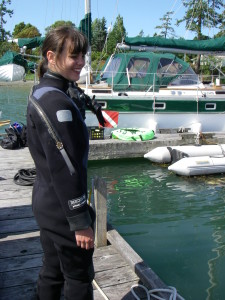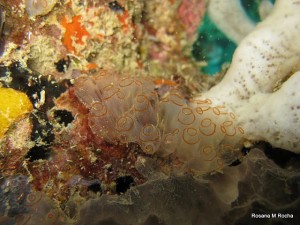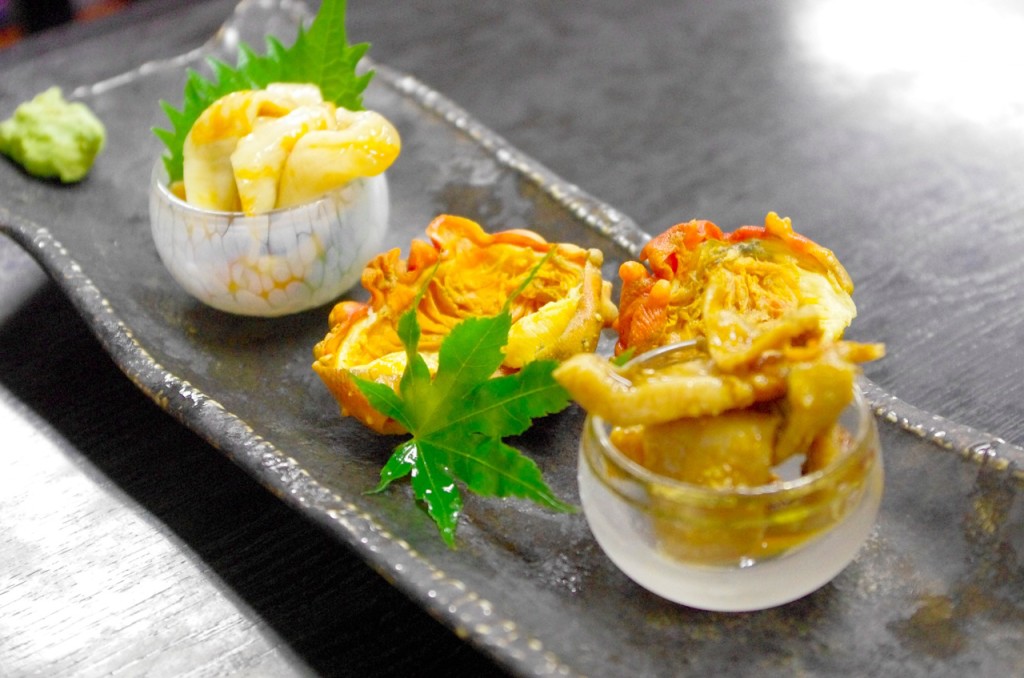
Christina Simkanin prepares to dive to survey ascidians. (Credit: Natalia Filip, University of Victoria, BC, Canada)
by Emily Li
Smithsonian biologists are on the trail of invasive ascidians. But with roughly 2300 species worldwide, describing these marine filter feeders (also known as “tunicates” or “sea squirts”) for a Most Wanted sign is tricky. Some ascidians are solitary; some are social. Some breed sexually, some asexually. Some, like Botrylloides magnicoecum, form large colonies of what look like octopus tentacles ringed in gold and highlighter blue. Others, like Rhopalaea crassa, resemble a cross between ghostly butterfly cocoons and pastel-colored pencil grips, while Polycarpa aurata is bulbous and mustard-yellow, with navy-blue veins that flare into trumpets.
When they invade new territory, ascidians can leave trails of damage in their wakes—but not always in ways scientists predict. In a new study published in the July issue of Marine Biology, a team of Smithsonian researchers, including marine ecologist Christina Simkanin of the Smithsonian Environmental Research Center (SERC), tracked their invasions across North America.
What they found seemed simple at first: North America’s 26 non-native ascidian species have spread so much they’re now established along nearly 3000 miles of its coastlines. But a few surprises were hiding in the details.
Ascidians from sea to shining sea

A colonial mangrove tunicate (Ecteinascidia turbinata). (Credit: Rosana Rocha, Universidade Federal do Paraná, Brazil)
For more than 15 years, the Marine Invasions Research Lab at SERC has been conducting field surveys and literature reviews of invasive species along the Atlantic and Pacific shores of North America. The lab puts out settlement plates in around 40 bays in the United States, Canada, and Mexico, and then collects and records any organisms that have moved in. With over 100 plates at some locations, some of which are sampled more than once, the number of plates totals more than 15,000.
“We’re having some storage issues,” Simkanin said with a laugh.
Out of all the species that turn up, there’s good reason why the Marine Invasions Lab focuses on ascidians. Not only are they as beautiful as they are destructive, but they also provide insight into how marine species are moving around the globe.
“They’re somewhat like ecological experiments in that they’ve been transported and introduced into a new area and they’re spreading from that region, and all of that is in recordable time,” Simkanin explained. “You can ask interesting ecological questions using that as a model.”

Christina Simkanin clearing a fouling plate for an ascidian experiment. (Credit: Natalia Filip, University of Victoria, BC, Canada)
When it comes to ascidians, Simkanin and her coauthors are leading the investigation. Until this study, no one had compiled enough information to form a continent-wide picture of their distribution. It appears that ascidians seem determined to fill their passport pages—but their itineraries aren’t straightforward. Simkanin was surprised to find that while San Francisco Bay is generally regarded as the most invaded region on the West Coast, non-native ascidians are more common in southern California, near San Diego. It’s possible that, like many tourists, they prefer warmer climates.
But it’s not just a question of where ascidians are spreading. It’s also a question of how. Ascidians aren’t moving themselves; they’re only mobile during a larval stage that usually lasts less than a day, and can’t travel much more than a mile. Simkanin believes ascidians are piggybacking on the hulls of commercial ships and recreational boats. Then, when they come into contact with structures in a new port or release their larvae into foreign waters, they officially earn their invasive stripes. If this is the case, trade links between North America and the Indo-Pacific—the highest region of ascidian biodiversity—may also help to explain these patterns.
A big pain in the aquaculture
Unfortunately for ascidians hitching a free ride, there’s good reason for us to minimize their spread. Not only does hull fouling slow ships and boats, but ascidians are expensive houseguests. Their preferred amenities—hard surfaces—mean they make themselves at home in aquaculture farms, where they take advantage of mussels, oysters, and other shellfish. Aquaculture facilities must clean off all the ascidians before they can sell the shellfish. In New Zealand, the invasive ascidian Styela clava cost aquaculturists up to $9.4 million.
“Ascidians basically make it really difficult for shellfish growers,” Simkanin said. “They don’t kill the mussels, but they make processing costs really high.”

Three varieties of cooked ascidian served at the Minami Sanriku shopping district in Japan. (Credit: Tomoaki Inaba)
One potential strategy for controlling ascidians might lie in an unexpected place: your taste buds. While eating farmed invaders may not help stop their spread, it can play an important role in raising awareness. Simkanin personally isn’t a fan of the chewy, oyster-like texture of cooked ascidians, but they’re common in Korean markets, and some regions in the United States are exploring the idea of cultivating ascidians in aquaculture facilities and getting them to high-end restaurants.
In the meantime, proactive regions are exploring more potentially effective solutions. New Zealand and California are already mandating that ships regularly clean their hulls. But there’s more that can be done, from recording shipments in and out of aquaculture farms, to cleaning shellfish before shipping, to nationwide hull-fouling regulation.
But while shippers, aquaculturists, and ecologists generally agree that ascidian management is important, the devil is in the details. Subsequent research on hull fouling has found niche areas—like nooks and crannies behind the rudder, and the “sea chest” where shippers pump water in and out to cool the engine—that can house entire miniature ecosystems, including ascidians.
“That never gets cleaned because it’s really hard to, and wouldn’t increase fuel efficiency, so there’s no reason for a ship to clean it,” Simkanin explains.
But Simkanin is used to encountering labyrinths in her work. Now that she has a better idea of where ascidians are going, she plans on looking more into what makes some ascidians better invaders than others. “It’s kind of the same as ecology in general. You think you have an answer, and then you get one, but it leads to two more questions.”
Photo of cooked ascidians used under Creative Commons license from Tomoaki Inaba.

